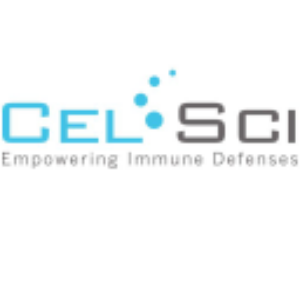CEL-SCI Corporation Issues Letter to Shareholders
- Multikine® reduced and eliminated tumors within 3 weeks and before surgery
- Nearly 4-year median overall survival benefit in the radiation-only group
- Data presentations at ASCO and ESMO world-leading peer review cancer conferences
Dear CEL-SCI Shareholders:
The Phase 3 study of our investigational cancer immunotherapy, Multikine* (Leukocyte Interleukin Injection), was the largest advanced primary head and neck cancer study ever conducted. We built a full-scale manufacturing facility and spent 10 years and over
Multikine Reduced and Eliminated Tumors Within Three Weeks and Before Surgery
The most important result of our study is this:
By contrast, there was not a single tumor response in the study control group, which did not receive Multikine. This means that the responses to Multikine could not have been by chance (p<0.00000001). We saw these responders in our Phase 2 studies as well, and the corroboration of these studies provides additional evidence of Multikine’s direct anti-tumor effect. In fact, as far as
Let me explain what I mean when I refer to the “radiation-only” group. Every patient in our Phase 3 study was slated to undergo surgery. Patients were then assigned by their doctors to one of two risk groups, which determined whether the patient went on to receive only radiation or radiation plus chemotherapy (concurrent chemoradiation) after surgery. This was the standard of care (SOC) treatment for these patients when we started the study and remains so today.
I note that we saw responses across all groups of Multikine patients, not just in the radiation-only group. While most tumor responses occurred in the Multikine radiation-only group, some also occurred in the Multikine chemoradiation group. There were zero tumor responses in the control group (384), so the statistical significance of tumor responses in the total Multikine population is extremely strong (p<0.00000000001). These responses to Multikine could not have been seen by chance, and they evidence the direct anti-cancer effect of Multikine on the tumor.
Nearly 4-Year Median Overall Survival Benefit in the
Typically, tumor response does not translate into improved survival, but Multikine is exceptional. More than
When all radiation-only Multikine+CIZ patients (CIZ contains supplements to enhance Multikine’s activity) were considered together, the five-year overall survival was greatly improved—
While the best immunotherapies today provide just a few months of survival benefit for recurrent or metastatic tumors, Multikine provided 46 months of survival benefit for newly-diagnosed disease in the radiation-only group. That is nearly four more years of median survival.
Patients in the chemoradiation group did not benefit from Multikine. In fact, these patients did less well than the control. This is believed to be because these patients needed their tumors removed quickly and could not delay surgery for an extra three weeks to receive Multikine. Should FDA approve Multikine, the product labeling will likely require that Multikine be contraindicated for use in persons who would require chemoradiation after surgery.
We have developed eligibility criteria to identify, with high accuracy, patients who are slated to receive only radiotherapy (not chemoradiotherapy) after surgery. These patients should be the ones to receive Multikine. This method was published at the prestigious peer-reviewed ASCO cancer conference in
Our Phase 3 study represents the first reported survival benefit in a randomized controlled study for patients with previously-untreated advanced primary squamous cell carcinoma of the head and neck in many decades. Others have tried and failed in head and neck cancer, including two recent failures by Merck and AstraZeneca in the last couple months:
Manufacturer |
Drug |
Study |
Outcome |
Pfizer & Merck |
Bavencio |
JAVELIN 100 |
Terminated |
AstraZeneca |
Durvalumab |
KESTREL |
Failed |
|
Afatinib |
LUX-Head&Neck 2 |
Failed |
Glaxo |
Feladilimab |
INDUCE-3/ INDUCE-4 |
Terminated |
Bristol Meyers |
Opdivo + Yervoy |
CHECKMATE-651 |
Failed |
Pfizer & Merck |
Bavencio |
GORTEX-REACH |
Failed |
Merck |
Keytruda |
KEYNOTE-412 |
Failed |
AstraZeneca & Innate |
Monalizumab + Erbitux |
INTERLINK-1 |
Terminated |
Pre-Specification of Our Analysis
“Additional analyses will be performed for the risk group assignment and for the type of therapy administered (radiotherapy, concurrent chemoradiotherapy) following surgery. The major prognostic factor for the subjects is the assignment to either the ‘high risk’ or ‘low risk’ group….”
We did this because it was obvious that there might be different outcomes for the risk groups, since they received different treatments. That is why the protocol said that risk group assignment was “the major prognostic factor.” FDA and 23 other regulators around the world reviewed this protocol and allowed the study to proceed. The statistical analysis plan (SAP), which was finalized while we were blinded to the data, has the same pre-specification as the protocol.
There has been confusion from some critics who suggest that because the radiation-only group was a “subgroup,” the analysis of that group is meaningless. Although some subgroups can be meaningless when they are analyzed after reviewing the data, are not pre-specified, have a small sample size, and lack a biological reason, our analysis was done before we saw the data, it was pre-specified, has a large sample size, and has a biological reason, among other supportive aspects. We also rely on more than just a subgroup. The responder survival benefit was seen in the total Multikine population, where the death rate was
I would also like to address our www.clincialtrials.gov results page where the results of our study are discussed in more detail. We stated: “Low-risk assessment and data analysis was never performed during the study and was done only after database lock.” Some critics were perhaps confused and claimed that this meant we did our analysis after reviewing the data, something that one is not supposed to do, but our statement means the opposite. The analysis was set forth in the original protocol and in the SAP and was not performed until after the SAP was made final.
Peer Reviewed Data Presentations at ASCO & ESMO
In peer-reviewed settings such as at the highly-respected
Our results are exceptional and cannot be dismissed, particularly because they are driven by tumor responses with survival benefits that arise directly from Multikine, and with statistical significance many orders of magnitude better than the required level. Given that no other randomized study in decades has shown a survival benefit for these patients, the need for an improved treatment is very great.
Major FDA Filing Upcoming
We have met with FDA and have received their questions and comments. This is normal. We plan to submit a major follow-up package to FDA soon that will address those questions and comments. At about the same time, we plan to file the Clinical Study Report, which is typically filed with a biologics license application (BLA).
For those who ask “what is taking so long,” please keep in mind that we have done what no one else has done before. The last FDA approval for previously-untreated advanced primary head and neck cancer was decades ago. Our treatment is novel, and our data is extensive and solid. We can identify with high accuracy the patients who are most likely to have great overall survival benefit from Multikine, over 200,000 patients per year globally. We believe FDA and other regulatory agencies will recognize these patients’ dire need for a treatment better than what is available today. In addition, we continue to validate our manufacturing facility to ensure that we will be in compliance with the standards for BLA approval.
An Expanded Team Of True Experts
We have added incredibly experienced people to our team, including scientists, biostatisticians, regulatory counsel who worked at FDA, an oncologist who worked at FDA as a clinical reviewer, and more than half a dozen independent oncologists on our
Our work takes longer than the work for drugs that are already well known because we have developed a novel way of treating cancer. It is great to be the first to achieve something but being first does not make things easier. In the end, we will be measured by one thing only: whether we are successful. Every one of our steps forward is geared towards being successful and helping patients with cancer.
Look for our next set of peer-reviewed data that will be presented very soon at ESMO. Thank you for your patience and support.
Sincerely,
Chief Executive Officer
Forward-Looking Statements
This press release contains forward-looking statements within the meaning of Section 27A of the Securities Act of 1933, as amended, and Section 21E of the Securities Exchange Act of 1934, as amended. When used in this press release, the words "intends," "believes," "anticipated," "plans" and "expects," and similar expressions, are intended to identify forward-looking statements. Such statements are subject to risks and uncertainties that could cause actual results to differ materially from those projected. Such statements include, but are not limited to, statements about the terms, expected proceeds, use of proceeds and closing of the offering. Factors that could cause or contribute to such differences include an inability to duplicate the clinical results demonstrated in clinical studies, timely development of any potential products that can be shown to be safe and effective, receiving necessary regulatory approvals, difficulties in manufacturing any of the Company's potential products, inability to raise the necessary capital and the risk factors set forth from time to time in
* Multikine (Leukocyte Interleukin, Injection) is the trademark that
View source version on businesswire.com: https://www.businesswire.com/news/home/20220907005344/en/
(703) 506-9460
Source:







